One of my culinary goals this year was to stop being such a wuss about preparing Vietnamese noodle soups at home. Four months and some change into 2012, I’m stoked to have mastered Bò Kho (Vietnamese beef stew), Bún Riêu Cua (Vietnamese crab and tomato soup), and most recently, Hủ Tiếu Mì (Vietnamese Pork Noodle Soup).
This most recent accomplishment coincided with my eldest cousin moving into town. Hủ Tiếu Mì is his absolute favorite noodle soup, and he requested that I make a huge vat of it just as soon as he arrived. He also asked for wontons to go with it, but that will be for another time. I need to concentrate on and conquer one dish at a time.
To learn the ins and outs of this Chinese-influenced noodle soup, I sought assistance from my aunt Thao. Something that she mentioned more than once was the importance of having a clear soup. To achieve this, the pork bones used to make the broth needs to boiled and cleaned, and one has to be diligent about skimming off any fat or foam that rises to the surface. Clear broth. Full bellies. Can’t lose.
This recipe makes about a dozen bowls worth, which is just about perfect in my mind. My cousin came over twice for dinner along with his fiancee and took leftovers for breakfast the following morning. Making a tremendous amount of food and having family over to enjoy it made me feel like I was continuing our family’s great tradition of nourishing and over-stuffing. This is what Vietnamese food is all about.
For broth
- 6 pounds pork bones (neck or spine—Grandma says that spine is tastiest)
- 1 daikon, peeled, trimmed, and cut in half or thirds
- 1 cup dried shrimp or 2 dried cuttlefish
- 7 tablespoons salt
- 2 tablespoons fish sauce
- 1 tablespoon sugar
- 1/2 tablespoon monosodium glutamate (optional)
For toppings and garnish
- 1.5 pounds ground pork
- 1.5 pounds pork shoulder/butt
- 2 bunch scallions, chopped
- Salt
- Pepper
For noodles
- 2 pounds thin or wide egg noodles (mì) or wide rice noodles (hủ tiếu), prepared according to directions on package
Make broth
Place the pork bones in a large stockpot. Fill the stockpot with enough water to cover the surface of the bones and bring to a boil. The pork bones will have some impurities that need to be washed away, so once the water comes to a boil, discard it and collect the bones in a colander.
One by one, rinse the bones to remove any scum. The cleaner the bones, the clearer the broth will be.
After giving the stockpot a thorough cleaning, fill it with 8 quarts of water and bring to a boil. Make sure to leave room for the water to rise when you add the bones and daikon. Once the water has come to a boil, add in the cleaned bones, daikon, and dried shrimp or cuttlefish. Let the broth come to a boil once more, skimming the surface as needed using a fine mesh skimmer.
Next, lower the heat to medium-low and bring all of the ingredients to a gentle simmer (such that you see a few small bubbles breaking the surface every few seconds) and cook for 3-4 hours, skimming off any fat or foam that rises to the surface. Be sure that the broth is not boiling to avoid a cloudy broth. If the broth reduces too much, add additional water.
Finally, season the broth with salt, fish sauce, sugar, and monosodium glutamate if using. The broth should taste just a touch saltier than one would expect to desire because the noodles and garnishes aren’t seasoned for the most part.
Make ground pork topping
While the broth is simmering on the stove, prepare the garnishes and toppings. Combine the ground pork with 1 teaspoon of salt, 1 teaspoon of black pepper, and chopped scallions (one bunch, white parts only). Once the pork mixture is thoroughly combined, cover, and set in the refrigerator.
Make fried pork topping
In a saute pan with a lid, heat two tablespoons of oil over medium heat. Once the oil is hot, add in the pork shoulder/butt and cover with the lid. The goal is to sear and caramelize the pork’s exterior and fully cook the interior. Turn the pork every 5-10 minutes as each side browns.
Repeat until each side of the meat has been seared and the interior is fully cooked. Set aside to cool completely.
The meat is ready to be sliced once it is completely cool.
Assemble Hu Tieu Mi
Place a portion of noodles in each soup bowl and garnish with chopped scallions (white and green parts) and slices of fried pork.
In a medium-sized saucepan over medium-high heat, ladle in enough broth for the number of servings that you are preparing at that time, approximately 2 cups of broth for each bowl. Bring the broth to a boil and add the ground pork mixture, approximately 1/4 cup per person.
Once the pork is completely cooked, ladle the hot broth into the prepared noodle bowls. Serve immediately with additional black pepper.
Makes 10 to 12 servings. The recipe can be easily halved both in proportions and cooking time if necessary.
[For Printable Recipe Click Here]
More Vietnamese recipes on Gastronomy:
- Bánh Bột Lọc – Clear Shrimp and Pork Dumplings
- Bánh Cuốn – Vietnamese Rice Crepes with Ground Pork and Mushrooms
- Bánh Giò – Minced Pork and Rice Dumplings
- Bánh Mì Tôm Chiên – Shrimp Toasts
- Bò Bía – Vietnamese Jicama, Carrot, Chinese Sausage, Egg, and Dried Shrimp Rolls
- Bò Kho – Vietnamese Beef Stew
- Bún Riêu Cua – Vietnamese Crab and Tomato Soup
- Cà Dê Nướng – Roasted Eggplant with Soy Sauce and Chilies
- Cà Ri Gà – Vietnamese Chicken Curry
- Canh Chua Chay – Vegetarian Sour Soup
- Chả Giò – Vietnamese Egg Rolls
- Cháo Chả – Porridge with Braised Pork Sausage
- Cơm Chiên – Vietnamese Fried Rice
- Gỏi Cuốn – Vietnamese Pork and Shrimp Rolls with Hoisin Dipping Sauce
- Mì Cà Ri Gà – Chicken Curry with Fresh Egg Noodles
- Mom’s Lollipop Fried Chicken
- Nui Lòng – Grandpa’s Spaghetti with Offal
- Nước Chấm Chay – Vegetarian Vietnamese Dipping Sauce
- Pasta with Eggs and Pork Floss
- Phở Chay – Vegetarian Phở
- Thịt Kho – Caramelized Braised Pork and Eggs
- Thịt Nướng – Vietnamese Grilled Pork
- Đậu Hũ Kho – Braised Tofu with Mushrooms and Tomatoes
- Đậu Hủ Xả Ớt – Fried Tofu with Chilies and Lemongrass

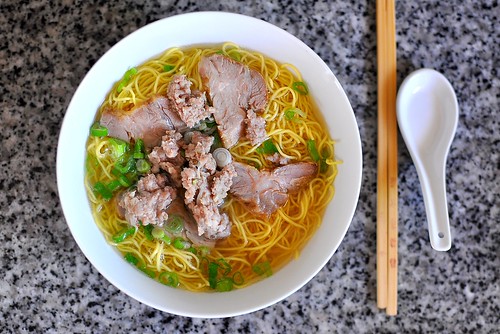
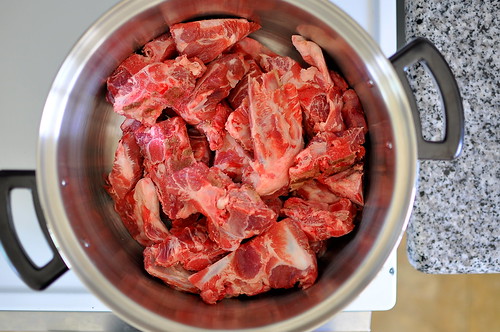
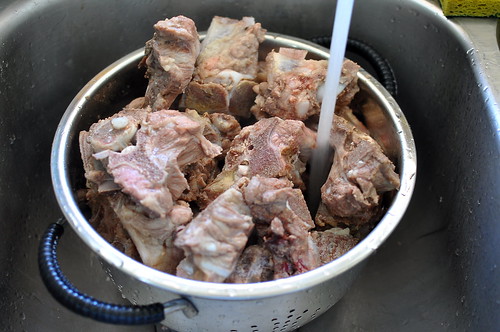
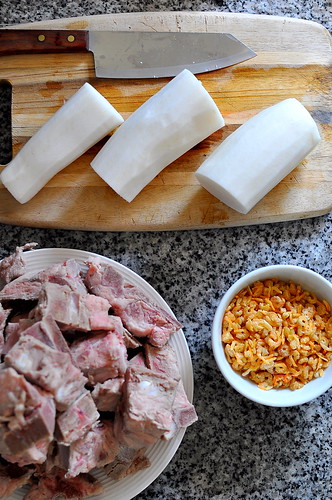
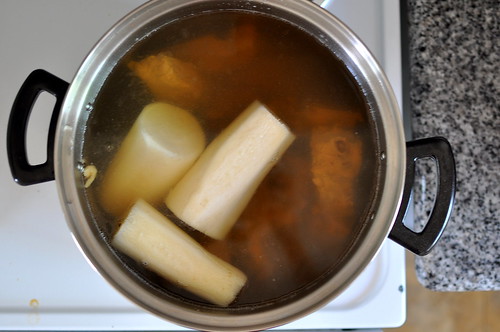
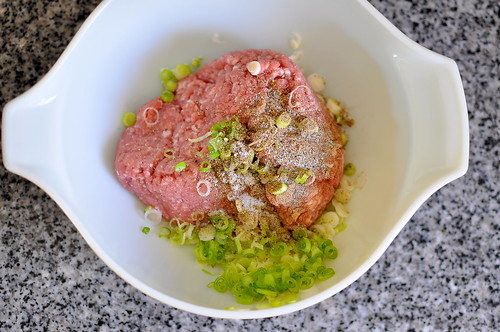

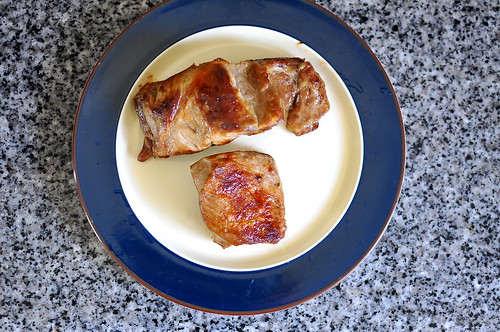
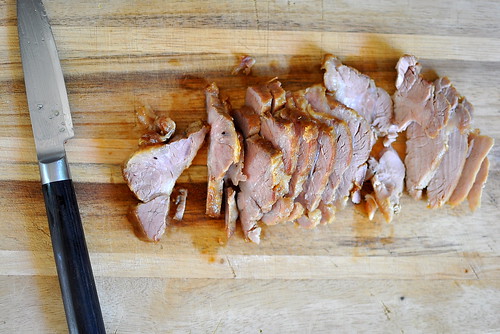
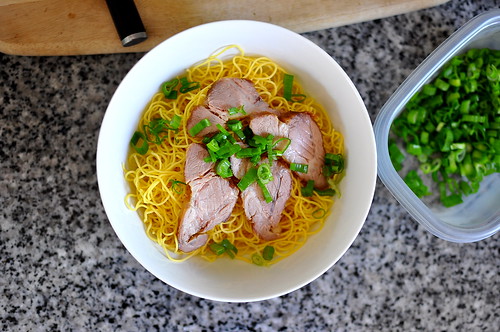

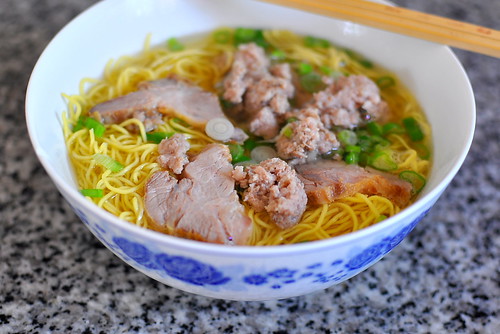
good job.
Mom
Looks great! I need to get over my fear of making Vietnamese noodle soups as well. This is a great starting point.
I have been a long time reader and observer. I have tried some of your recipes with mostly success and I will give this one a try.
Cheers
This looks so good! I want to make this for my family ASAP!
This looks great Cathy – light and clean.
Good for you! This is a pretty good start. I’m sure in no time you’ll start jazzing up that bowl with fresh shrimp, fried shallots, and making the pork shoulder into xa xiu 🙂
For the clearest broth, I strain mine through a meshed collander lined with paper towel. Trick works every time, not just for the impurities, but it also catches the fat as well. I used to make this soup with the bones you use but switched to making this soup with pork leg bones after watching a cooking show from vietnam. It’s slightly cheaper than the spine pieces and it renders the broth a little richer since there’s more marrow in the leg bones.
Happy cooking and keep it up!
twee – Thanks, Mom!
Sharon – If I can do it, YOU can do it! No wusses allowed.
Fusion – I made this dish several times to make sure the recipe was fool-proof. Please let me know if anything needs extra clarification.
Sarah – 🙂
Darin – And porky. Oh, so porky!
Anh – Fresh shrimp and shallots—heck yes! And maybe some hu tieu dai (transparent noodles) too! First up, wontons to satisfy my cousin. I will make my next vat with pork leg bones. Thank you for the tip!
This takes some work, but looks soooo worth it. Now, I just need to find twelve people to come help me eat it.
Esi – This recipe halves beautifully. Take a walk on the Vietnamese side 😉
Mmm, this soup looks fabulous! Will put on my to-do list… thank you! 🙂
You can’t call me Aunt Thao. I’m Ut 🙂
Seven tablespoons of salt? Really? Just checking to be sure. I made beef stock over the weekend and used about 2 tablespoons and it seemed salty, so I really need to be sure. Thanks.
Susan: It is correct. However, you might be more sensitive to salt, so I would add a tablespoon at a time to make sure it’s to your liking 🙂 It’s easier to add salt slowly than to remove it!
Roasting the bones before putting in a pot to make broth is highly recommended. Doing this would improve clarity of the broth. Adding some pure rock sugar would help bits of cooked blood and debris clump together so as to make skimming them easier. You will need to skim the gunk that floats to the top as the broth being made. To add flavor to the ground pork, I’d recommend stir frying it first with sesame oil and adding minced garlic, white pepper, salted radish (comes in small ceramic pot and is fermented). As for the meat, you can buy Cha Siu seasoning and marinate the pork and then broil it. Always add salt to the broth to suit your taste last. Recipes are generally can and should be tweaked to meet your personal taste.
What do you do with all the meat from the neck bones
Gnaw it. Like a caveman. Thuy
Hahaha, thanks. Also, just curious why you don’t cut the daikon up smaller? Do you eat it or just use it for flavoring the broth?
Just for flavoring the broth, Thuy.
Hi, this is my first time making any complicated dishes. Do I let it simmer with or without the lid? Do I add seasoning to the broth at the end or as it is getting simmered?
Mai – Thank you for your questions. Please simmer without the lid. And it’s best to season toward the end as the broth evaporates a bit as it cooks. Good luck!